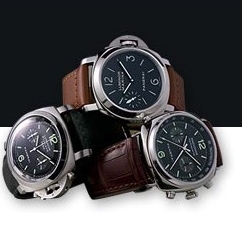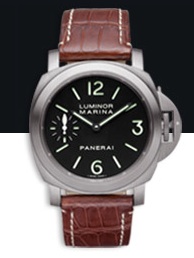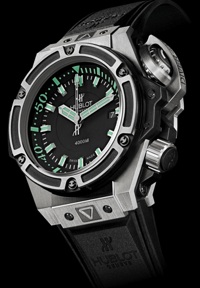Articles and News
TRENDSPOTTING: WATCH LOVERS SAY “SUPERSIZE ME!” | December 28, 2011 (0 comments)

New York—If health experts are worried that Americans’ rear ends are getting larger, jewelers should rejoice in the fact that so are luxury wristwatches. According to this article in the New York Times, timepieces are one thing that’s bucking the trend to go smaller.
Electronics like laptop computers and digital cameras seem to get lighter, thinner, and sleeker with every successive model launch. McMansions have fallen out of favor and we’re seeing fewer Hummers and more Minis on the road. To wit, Italian carmaker Fiat is re-entering the U.S. market after a long hiatus here, with its own version of a Mini and even Detroit is focusing on small. Yet status wristwatches are getting bigger and bigger while, as the Times points out, there’s a real irony in the trend toward supersized wristwatches in a digital culture where there’s no real need to own a watch at all.
Edward Faber, owner of the Aaron Faber Gallery in New York, told the Times the trend began—as so many do—in Hollywood. The Italian watchmaker Officine Panerai introduced its oversized sports/diving watch to the United States about a decade ago, and celebrities, fashionistas, and the sports crowd picked up on it. From there, case sizes took off.

Panerai's Luminor has a face that's 44 mm in diameter.
Roberta Naas, a veteran journalist and expert in the luxury watch industry, agrees with Faber’s description of Panerai’s role in sparking the trend for big watches, but adds that Swiss watchmaker Hublot also was important in building the trend. But, she told The Centurion, in the world of watch collecting, big sporty timepieces never will become more important [to serious collectors] than complicated watches. Instead, she said, they co-exist in order to give collectors a taste option.
Prior to Panerai’s popularity, a watch with a diameter of 36 – 38 mm was considered large; now, it’s quite modest. The most stylish new watches invite comparison to a hockey puck or a hamburger. Even women are sporting small spaceships on the wrist—many popular women’s models now are bigger than traditional men’s watches were 20 or 30 years ago.
Faber told the Times that watches of similar proportion were last seen in World War II, when pilots needed a very large, easy-to-read face that could be seen in the cockpit in all kinds of weather and light conditions.
“Obviously in true sports arenas they have a real reason for being,” said Naas. Larger dials allow for easy reading, such as Faber’s pilot example or underwater with a diver’s watch. Larger cases also allow for more functions, such as chronographs, chronometers, altimeters, tachymeters, and so forth, Naas told The Centurion. And in the case of pilots’ watches, a larger case often will hold a soft inner iron case to protect against the effect of magnetism.
“So there is the functional performance side, as well as the aesthetic side,” said Naas.
But with huge watches, there’s a value perception, too: Michael Sandler, vice president of watch retailer Tourneau, told the Times that if shoppers are spending a lot [on a watch] they want to feel like they’re getting a lot.
It’s the exact same answer given by many restaurant chains in response to nutritionists’ complaints about too-hefty portion sizes. American consumers want value, like Sandler says, and for many, that translates to quantity. In a restaurant, it means the standard portion size of many common foods have doubled or more over the last 20 years, and in watches, it means faces that can be as large as 48 mm in diameter, with corresponding case thickness and bracelet heft increasing accordingly. And—always a plus for the status seeker—they can be seen across the room.

Hublot's Oceanographic is a can't-miss-it 48 mm in diameter.
But for every trend, there’s always a countertrend. Naas says in mechanical watches, ultra-thin is all the rage. They’re really hard to build and are considered one of the finest complexities in the world. They also have a retro appeal—thin watches debuted in the 1950s by Piaget and were all the rage by the 1970s, and watchmakers frequently mine their own archives for inspiration for new models, she adds.

Piaget's Altiplano boasts mechanical complications in a sleek, ultrathin case--a signature of the brand for more than four decades.
For women, Naas sees archival references as well, especially Art Deco inspiration from the 1920s, the Baume & Mercier “Hampton” look from the 1940s, and unusual case shapes and thin sizes inspired by timepieces from the 1950s through 1970s.


Left, a women's rose gold and diamond Michele Deco watch takes its inspiration from the era of the same name; right, Baume & Mercier's classic Hampton series is both still in production and still inspiring watch design in general.
But the Times says a status-seeker’s watch still will be big. Driving a Hummer today will get a man noticed in the wrong way, but a big honker of a wristwatch makes the same statement in a more current way.







